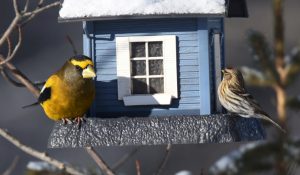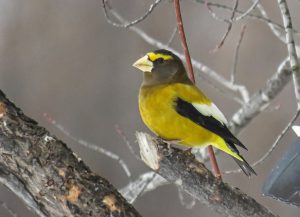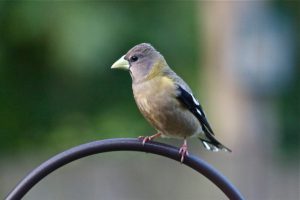Native Animal Profile: Evening Grosbeak
Multiple species of finches make their home in Maryland. Some are year-round residents while others, like the evening grosbeak, are part-time visitors.
Evening grosbeaks are chunky finches. Males have striking yellow and black plumage with prominent white and black wings. Females are mostly gray and also possess white and black wings. Both sexes have thick, conical shaped bills with adult males having ivory colored bills and females and immature birds having greenish-tinged bills.
Evening grosbeaks are primarily found in the southern parts of Canada throughout the year. Their winter range, however, includes much of the U.S. They are considered irregular migrants, venturing south during years when food is scarce. The primary driver for migration is cone crops. These migrations are known as irruptions and generally occur every 2-3 years. In the east, however, the frequency has declined. In Maryland, they have been spotted around the state in 2018, delighting birders across our landscapes.
Evening Grosbeaks are omnivorous, consuming insects and other invertebrate prey in the spring, as well as berries, nuts and seeds. Spruce budworm larvae are often part of their diets. One bird was found to have budworms make up 80 percent of its stomach content through a study conducted in 1952. Large seeds like ash, maple and sunflower are often preferred. The buds of cherry, elm, maple and oak have also been found to be foraged on by Evening Grosbeaks. Interestingly enough, evening grosbeaks are also highly attracted to salts and other minerals.
Breeding times vary by location. In Colorado, birds begin courtship displays in April, while birds in eastern areas display in May. Pair bonds form in the winter, with males often bringing food and twigs to potential mates before they migrate to breeding grounds. Nest building begins almost immediately as birds arrive. Despite this fast turnaround, evening grosbeaks rarely nest more than once in a breeding season. Nests are built up in trees with twigs and other materials, and 2-5 eggs are laid. Eggs usually hatch after two weeks, and the young fledge another two weeks later.

Evening grosbeak and common redpoll at a feeder by Andy Reago and Chrissy McClarren, Flickr CC by 2.0
Despite being songbirds, evening grosbeaks do not have consistent songs. Cornell Lab of Ornithology describes them as “sweet, piercing calls and burry chirps.”
While evening grosbeaks are not a regular Maryland bird, you can take advantage of the 2018 irruption by providing fresh seed. They will come to feeding tubes and platform feeders, as well as feast on seeds on the ground. If you are lucky enough to see an Evening Grosbeak in Maryland this year, please consider reporting the sighting to eBird and/or to Project FeederWatch. We also would love to see any pictures too!
References
- eBird. 2012. eBird: An online database of bird distribution and abundance. eBird, Ithaca, New York.
- Evening Grosbeak Life History. 2018. Cornell Lab of Ornithology, All About Birds.
- Gillihan, S. W. and B. E. Byers. 2001. Evening Grosbeak (Coccothraustes vespertinus), version 2.0. In The Birds of North America (A. F. Poole and F. B. Gill, Editors). Cornell Lab of Ornithology, Ithaca, New York.
- Mitchell, R. T. 1952b. Consumption of spruce budworms by birds in a Maine spruce-fir forest. J. Forestry no. 50:387-389.
Happy holidays HabiChat fans!
While I am not a big fan of wintertime, I am excited to see new visitors to my backyard.
Since winter is a great time for bird watching, much of this HabiChat is dedicated to projects and plants that will help local bird species. Learn about local research on native plants and how they help native birds, read up on evening grosbeaks and why their return to Maryland is special, learn about our native silky dogwood, and finally, keep an eye out for finch eye disease.
Winter is also a time for maintenance projects, so don’t forget to clean out and repair nest boxes and prune your shrubs and trees. Remember, water is crucial to many species this time of year. Consider adding a heated bird bath or pet water bowl to your landscape to help local wildlife. If you are looking for fun projects to do with the kids, try a winter safari or making seed wreaths.
In addition, the University of Maryland Extension’s Woodland Stewardship Education has several upcoming events that may be of interest to backyard enthusiasts. Registration for the spring session of The Woods in Your Backyard online course will be open soon. This self-paced, non-credit course runs 10 weeks from March 5-May 21, 2019, helping landowners convert lawn to natural areas and to enhance stewardship of existing natural areas.
As a final note, the Maryland Amphibian and Reptile Atlas is now available, containing information on more than 80 reptile and amphibian species. Data was collected by local biologists and nearly 1,000 community scientists. Each species is given a detailed account of identification characters, life history information, and where it was found across the state.
Happy Habitats,
Kerry Wixted
Click here to have HabiChat—the quarterly backyard wildlife habitat newsletter from the Wild Acres program—delivered right to your inbox!
In this Issue
Habitat Tips: Native Birds Need Native Plants
Loving Birds to Death & the Importance of Cleaning Feeders
Native Animal Profile: Evening Grosbeak
Native Plant Profile: Silky Dogwood




 1-888-373-7888
1-888-373-7888 233733
233733